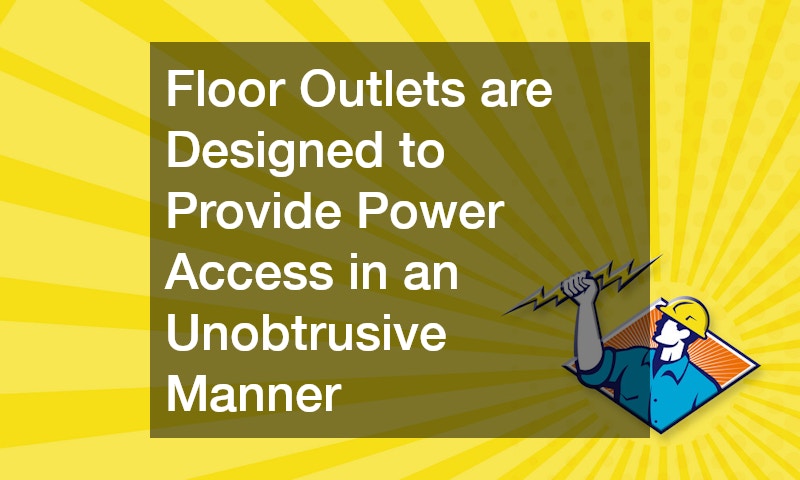In modern construction and design, convenience and functionality often go hand in hand. One innovation that exemplifies this blend is the floor box outlet. This versatile solution is increasingly becoming a staple in both residential and commercial settings.
Understanding what a floor box outlet is, and assessing its suitability for your specific project, can dramatically enhance both the aesthetic and utility of a space. In this article, we will explore the concept of floor box outlets in detail.
By shedding light on its various applications and advantages, we aim to help you determine whether incorporating a floor box outlet into your project will fulfill your needs.
Understanding Floor Box Outlets
Floor box outlets are electrical connections installed flush with the floor surface. These receptacles are designed to provide power access in an unobtrusive manner, making them perfect for spaces where wall outlets aren’t practical. Commonly found in conference rooms, offices, and open plan areas, they offer a seamless blend of functionality and aesthetic appeal.
The installation of floor box outlets involves a housing unit that sits below the floor surface, with the outlet part accessible via a cover. This design ensures that only the outlet cover is visible, thus maintaining the visual flow of the flooring while providing easy access to power sources. They are available in various shapes, sizes, and finishes, allowing integration into virtually any flooring material.
Materials like hardwood, carpet, concrete, and tile can all accommodate floor box outlets, making them incredibly versatile and adaptable. Their installation requires careful consideration of both the electrical and structural elements to ensure safety and durability. Moreover, the seamless aesthetic integration they offer can be a driving factor for choosing these outlets in both new builds and renovation projects.
Advantages of Using Floor Box Outlets
One of the primary advantages of floor box outlets is their ability to provide power access in areas where traditional wall-mounted outlets might be impractical or aesthetically unpleasing. They support a more organized, clutter-free environment by eliminating the need for extension cords stretched across open areas. This feature enhances both the safety and appearance of a space.
Another advantage is their contribution to a more flexible room layout. Since these outlets are not bound to walls, they allow for varied furniture positioning, making them ideal for dynamic environments such as conference rooms or collaborative workspaces. This flexibility can transform how a space is used, prioritizing functionality without compromising design.
Furthermore, floor box outlets promote safety as they reduce tripping hazards associated with trailing cords. They ensure that power is readily available where needed, thus supporting the use of technological devices and appliances without the constant reshuffling of furniture or reliance on power strips. The peace of mind offered by a more organized and safer environment cannot be underestimated.
Considerations Before Installing Floor Box Outlets
While floor box outlets offer numerous benefits, it’s essential to weigh various factors before deciding on their installation. One critical consideration is the location of the outlets. Planning where these should be placed is paramount, as it influences both the room’s utility and safety.
Different flooring materials will require specific installation techniques and considerations. For instance, installing a floor box outlet on a concrete floor will involve a different process than installing on carpeted flooring. These specifics can impact both cost and installation time, making it vital to consult with professionals who can offer guidance based on your unique flooring type.
Finally, consider the type and volume of power needs expected in the area where you plan to install the outlets. Ensure that the chosen floor box outlet can support these requirements. Investing in an outlet that permits more power access than initially anticipated can future-proof the space, accommodating new technologies and changing requirements over time.
Is a Floor Box Outlet Right for Your Project?
Determining the suitability of a floor box outlet largely depends on the specific needs and constraints of a project. Assessing the balance between aesthetic desires and functional requirements can guide this decision. If the project aims to maintain an open and flexible floor plan without clutter, floor box outlets can be a favorable choice.
Additionally, projects that require frequent rearrangement of furniture or equipment will benefit significantly from floor box flexibility. They provide the necessary power access with minimal disruption to space layout, facilitating a more versatile utilization of the area. This adaptability can be especially beneficial in commercial settings where the dynamic use of space is a priority.
Ultimately, involving a professional electrician in the early planning stages can provide valuable insights and help anticipate potential challenges. By understanding the precise power needs and spatial considerations, you can make a well-informed decision on whether to incorporate floor box outlets into your project. This proactive approach ensures the long-term success and functionality of the installation.
Incorporating floor box outlets into a project can elevate both the functionality and aesthetics of a space. Their ability to provide concealed power access makes them a favored choice in modern design, where open spaces and flexible layouts are prioritized. Considering the project’s unique requirements and consulting with experts ensures optimal outcomes.
By weighing the advantages and considerations discussed, you can determine if floor box outlets align with your project’s goals. Their practical benefits, coupled with subtle integration into various flooring environments, underscore their growing popularity in construction and renovation activities.
Ultimately, floor box outlets offer a strategic solution to manage power access without compromising the visual or functional aspects of a space. Given the right conditions and planning, they can indeed work for your project.



